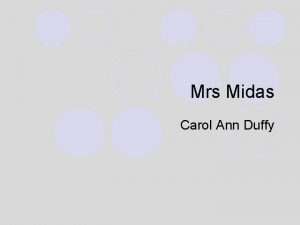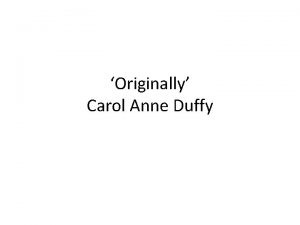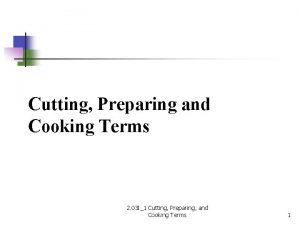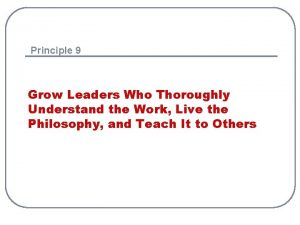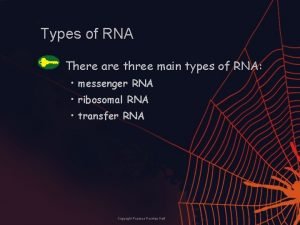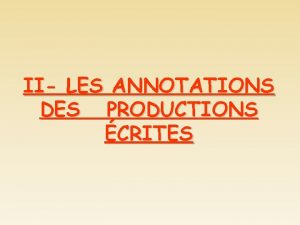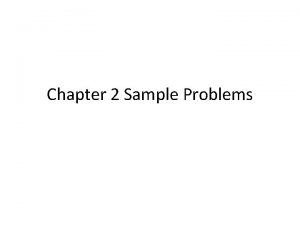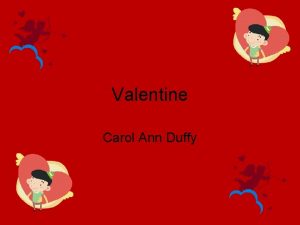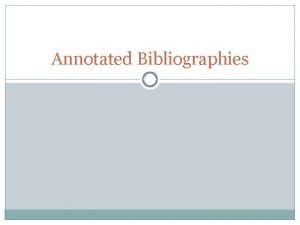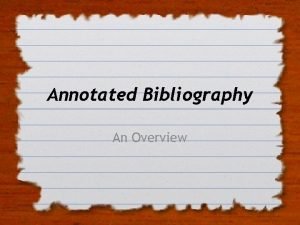Duffy Commonalities Thoroughly study your notes annotated copies















- Slides: 15

Duffy - Commonalities Thoroughly study your notes / annotated copies of all six poems: • War Photographer • Originally • In Mrs Tilscher’s Class • The Way My Mother Speaks • Valentine • Mrs Midas

Final Question – Structure a) 2 marks can be achieved for identifying things that the poem has in common with Duffy’s other work, as stated in the question. b) 2 marks can be achieved for references to the text provided in the question paper. c) 6 marks can be awarded for discussion of similar references to at least one other text by the writer.

Areas of Commonality In order to answer the final question effectively, you will need to write about areas of commonality between the poem you are given and other poems in the collection. Key areas of commonality we will focus on are: 1. Reflecting on the past 2. Love 3. Marriage 4. Ending Relationships 5. Time and Memory 6. Loss 7. Destruction 8. Physical / Emotional Pain 9. Loneliness / Solitude 10. Structure This list is not exhaustive.

Areas of Commonality 2 – Reflecting on the Past • War Photographer – written in third person, showing photographer, reflecting with delayed shock after returning home to England, on experiences of working, taking pictures, capturing horrific images, in war zones around the world. • Originally – written in first person, from poet’s own perspective, reflecting resignedly on inevitability of change in process of growing up and identity loss after moving away from place of origin and settling elsewhere. • In Mrs Tilscher’s Class – Duffy / speaker reflects on her relationship with her primary school teacher, and how this changed as she moved from childhood to adolescence. • The Way My Mother speaks – Duffy reflects on the profound relationship she has had with her mother, and on how the strong bond she has with her will continue into adulthood. • Mrs Midas – Mrs Midas reflects on her husband’s discovery of his ability to turn what he touches into gold, and how this led to the breakdown of their relationship.

Areas of Commonality 3 - Love Key ideas: four of the six poems deal with theme of love. • Mrs Midas portrays love that was mutual and passionate but ruined by husband’s “idiocy…greed…selfishness” and is unfulfilling by ending their sex life and preventing her from having the baby she longed for. • Valentine pragmatically portrays love that is initially mutual, passionate, but shows it can be ruined in time by infidelity or destroyed by possessiveness which becomes dangerous, “Lethal” to relationships. • The Way My Mother Speaks addresses the speaker’s (Duffy) enduring love for her mother, even after moving from the family home and progressing into adulthood • In Mrs Tilscher’s Class addresses the speaker’s (Duffy) love for her teacher, Mrs Tilscher, and how this changed as she grew into adulthood.

Areas of Commonality 4 - Marriage Key ideas: two of the six poems deal with the idea of marriage. • Valentine suggests that marriage is optional; “platinum loops shrink to a wedding ring” hints marriage is perhaps too possessive, constricting. • Mrs Midas portrays a marriage that ends in separation which the wife would not have wanted, due to the unreasonable behaviour of her husband.

Areas of Commonality 5 – Ending Relationships Key ideas: four of the six poems deal with the idea of the ending of relationships. • Valentine suggests relationships can bring unhappiness, in some cases due to a partner being unfaithful, or danger, in a partner’s extreme possessiveness, thereby requiring someone to be cut of another’s life. • Mrs Midas shows the unhappy demise of a relationship due to a partner’s behaviour and presumably the death of the husband. • In Mrs Tilscher’s Class deals with the way the speaker (Duffy’s) nurturing relationship with her primary school teacher ended as she grew closer to adulthood. • The Way My Mother Speaks deals with the idea that Duffy’s relationship with her mother does not end, despite becoming an adult and moving out of the family home.

Areas of Commonality 6 – Time and Memory Key ideas: five of the six poems deal with time and memory. • War Photographer shows time bringing about delayed shock when the developing photographs remind the photographer of the horrific original experiences. His memories don’t fade over time. The photographs preserve his memories. • In Mrs Tilscher’s Class shows Duffy reflecting on the fond memories she has of her primary school teacher, and of how this relationship changed when she moved towards adolescence. . • Mrs Midas shows how certain insignificant things like sunlight or apples can jolt her memory of her husband both at the time and before the breakup of their marriage and bring back vivid recollections that haven’t faded. • The Way My Mother Speaks shows how Duffy’s memories of her mother continue to be a source of reassurance for her, even as she becomes an adult. • Originally shows time bringing about identity loss due to gradual assimilation into, homogeneity with, a new community. Her memories of Glasgow gradually fade over time, a change that causes some guilt.

Areas of Commonality 7 - Loss Key ideas: all of the poems deal with theme of loss. • In War Photographer, photographs document loss of life – children presumably die in minefields; dead man whose wife assented to the photograph being taken is described as a “ghost”. Also he “stares impassively” at war zones he works in as if having lost power to be shocked or moved. • In Mrs Tilscher’s Class, Duffy reflects on how the nurturing relationship she had with her teacher was gradually lost as she moves towards adolescence. • In The Way My Mother Speaks, Duffy reflects on the loss of the close relationship she once had with her mother, while nevertheless recognising the profound impact that this relationship till continue to have with her. • In Mrs Midas, wife speaks of lost marriage, lost physical closeness with husband, lost opportunity to have baby. • In Originally, Duffy herself has lost her original home, accent, and ultimately Scottish, Glaswegian identity. • In Valentine, it is shown that couples can lose fidelity and ultimately relationships.

Areas of Commonality 8 - Destruction Key ideas: all poems except Anne Hathaway deal with idea of destruction. • War Photographer deals with violent destruction of war: children being victims of landmines, a husband dying in front of his wife, blood soaking into ground. • Mrs Midas shows a marriage and potential family destroyed by stupidity, greed and thoughtless selfishness of a husband. • In Valentine, possessiveness and infidelity can destroy relationships. “Lethal” and “knife” suggest violent, wounding, hurtful ends to relationships. • In Originally, Duffy’s memories of Glasgow as home, Glaswegian accent, Scottish dialect, sense of identity are destroyed by moving to England.

Areas of Commonality 9 – Physical / Emotional Pain Key ideas: all poems except Anne Hathaway deal with pain • War Photographer deals with the physical and emotional pain of war victims remembered and captured in pictures; idea of pain being on a scale, comparing extreme pain suffered in war zones to “ordinary pain”, trivial annoyances, of rural England; lack of pain felt by Sunday supplement readers on seeing images of war; disguised pain felt by photographer on returning to work in war zone. • Valentine suggests intense emotional pain, wounding caused by break up of relationship. • Mrs Midas shows wife’s regretful emotional pain at a marriage so needlessly, thoughtlessly ruined; husband’s physical pain during starving to death, thin and hallucinating. • Originally shows Duffy’s family’s emotional pain – anxious parents, crying brothers – at leaving familiarity of home; Duffy’s guilty pain at eventually becoming assimilated in new surroundings.

Areas of Commonality 10 – Loneliness / Solitude Key ideas: all poems deal with theme or idea of loneliness or solitude. • War Photographer begins with photographer being “finally alone”, having peace and solitude to develop pictures and deal with feelings of shock about war zones he has experienced. • Valentine suggests that relationships eventually bring “grief”, are not permanent fidelity lasts only up to a point, leading to break ups which leave former partners alone. • Originally shows Duffy lonely at first moving to England where all is unfamiliar and where “no one you know stays”. • Mrs Midas portrays both husband wife lonely – he dying in solitude in isolated caravan, she alone at home, missing him and opportunity to be family with a baby.

Areas of Commonality 11 - Structure: ways in which the construction of the poems reflect the content of them. • Valentine is written in free verse, seemingly unstructured, rather than any conventional form or pattern, in keeping with idea that love should not be constricted by marriage or possessiveness. • Havisham is written in 4 stanzas of 4 lines each. The regularity of stanza pattern suggests social conformity of marriage but unequal length of the lines, fact that many are run-on lines and lack of any regular rhyme scheme suggest random, irrational thoughts and feelings of persona and her unconventional existence as perpetual spinster amongst mouldering remains of wedding paraphernalia.

Areas of Commonality 11 - Structure: ways in which the construction of the poems reflect the content of them. • Mrs Midas is written in 11 stanzas of 6 unequal length lines each and with no regular rhyme scheme. Poem is a dramatic monologue and length of it reflects in how much detail persona wants to confide in us. The irregular line length and lack of rhyme make it sound like natural speech, a friend telling all to a friend. • Originally is written in 3 stanzas of 8 lines each. This regularity suggests continuity of being Scottish despite outward changes while lack of end rhyme suggests changes, differences. Stanza 1 describes journey from Glasgow; stanza initial isolation in England; stanza 3 assimilation and acceptance of change. Each stanza is a stage in a progression, in keeping with progression of growing up and changing described in poem.

Areas of Commonality 11 - Structure: ways in which the construction of the poems reflect the content of them. • War Photographer is written in 4 stanzas of 6 lines each, with regular rhyme scheme of abbcdd pattern in every stanza, i. e: 2 tercets per stanza comprisingle line unrhymed followed by rhyming couplet. This very strict pattern, exactly repeated, suggests every print from film exact replicas, every photograph exact record of horrific events. Regularity of stanzas and rhyme scheme also suggest orderliness of life at home in England in contrast to chaos of war abroad. • Anne Hathaway is written in 14 lines, like sonnet traditionally associated with love poetry, used extensively by Shakespeare – very appropriate as poem is about love. Many lines traditional 10 syllable length and iambic pentameter rhythm but not all and rhyme scheme not exact, so does not conform precisely to sonnet form, supporting Duffy’s view of Anne as not conforming to traditional idea of her as illiterate, abandoned wife at home in Stratford while Shakespeare pursuing career in London. Run-on lines between quatrains suggest close connection and continuous flow of love between couple. Final rhyming couplet used in Shakespearean style makes emphatic, clinching conclusion to poem: declaration that she hold on to treasured memories of him in same way as he treasured her physically in life.
 Commonalities among psychotherapies
Commonalities among psychotherapies Humanistic therapy aims to
Humanistic therapy aims to Mrs midas textual analysis
Mrs midas textual analysis Carol ann duffy valentine context
Carol ann duffy valentine context Carol ann duffy originally
Carol ann duffy originally Nothing is silent nothing is not silent
Nothing is silent nothing is not silent The good teachers duffy
The good teachers duffy Originally carol ann duffy annotated
Originally carol ann duffy annotated In his poem thanatopsis dgp
In his poem thanatopsis dgp Cut into small uneven pieces
Cut into small uneven pieces Thoroughly understand
Thoroughly understand Transciption definition
Transciption definition Www.cned.fr espace inscrit
Www.cned.fr espace inscrit Carries copies of the instructions for assembling proteins
Carries copies of the instructions for assembling proteins Annotations sur les copies
Annotations sur les copies Sedlor properties purchased office supplies
Sedlor properties purchased office supplies


